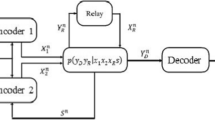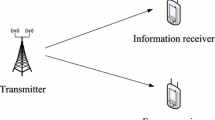Abstract
For a multiple access channel, each user has its own power constraint. However, when a multiple access channel is being considered as the dual of a broadcast channel, it must exploit the additional freedom in power allocation and the constraint should be a sum power constraint. Duality helps us to transform the non-convex problems in a broadcast channel to convex problems in a multiple access channel. This helps to solve sum-rate optimisation problems with linear power constraints. However, maximising the sum-rate does not completely characterise the entire rate region boundary, formally called as the Pareto frontier. This work first reviews some of the existing results of polymatroid formulation from the Pareto optimality perspective and then proposes a complete characterisation of the Pareto frontier to show its relationship with the sum-rate optimisation problem. The significance of decoding order on the achievable rate region is considered. The work also shows some of the decoding orders to be suboptimal in Pareto sense and proposes an algorithm to find the correct decoding order based on power allocation. Simulation results are presented to support the theoretical arguments.






Similar content being viewed by others
Notes
This means all the elements of \({\mathcal {S}}'\) are decoded before the elements of \({\mathcal {S}}\).
\(1\rightarrow 2\) means user \(1\) is decoded first, then after cancelling the interference, user \(2\) is decoded.
It can be shown that these definitions satisfy the required properties of a norm for a \({\mathbb {C}}^M\) vector [3, Appendix A].
This means all the elements of \({\mathcal {S}}\) are decoded before the elements of \({\mathcal {S}}'\).
Developed by CVX Research Inc. Austin (TX), US.
References
Annapureddy, V. S., & Veeravalli, V. V. (2009). Gaussian interference networks: Sum capacity in the low interference regime and new outer bounds on the capacity region. IEEE Transactions on Information Theory, 55(7), 3032–3050.
Boche, H., & Schubert, M. (2008). A superlinearly and globally convergent algorithm for power control and resource allocation with general interference functions. IEEE/ACM Transactions on Networking, 16(2), 383–395. doi:10.1109/TNET.2007.900362.
Boyd, S., & Vandenberghe, L. (2004). Convex optimization (2nd ed.). New York: Cambridge University Press. doi:10.1016/B978-012428751-8/50019-7.
Brehmer, J., Bai, Q., & Utschick, W. (2008). Time sharing solutions in MIMO broadcast channel utility maximization. In ITG Workshop on Smart Antennas (pp. 153–156). Wien.
Edmonds, J. (1969). Submodular functions, matroids, and certain polyhedra. In International Conference on Combinatorial Structures and Applications (pp. 69–87). Calgary. http://link.springer.com/chapter/10.1007/3-540-36478-1_2
Etkin, R. H., Tse, D. N. C., & Wang, H. (2008). Gaussian interference channel capacity to within one bit. IEEE Transactions on Information Theory, 54(12), 5534–5562.
Fung, C. H. F., Yu, W., & Lim, T. J. (2007). Precoding for the multiantenna downlink : Multiuser SNR gap and optimal user ordering. IEEE Transactions on Communications, 55(1), 188–197.
Goldsmith, A. J., Jafar, S. A., Jindal, N., & Vishwanath, S. (2003). Capacity limits of MIMO channels. IEEE Journal on Selected Areas in Communications, 21(5), 684–702.
Grant, M. C. (2004). Disciplined convex programming. Ph.D. thesis, Stanford University. http://www.stanford.edu/boyd/papers/pdf/mcg_thesis
Huh, H., Papadopoulos, H., & Caire, G. (2009). MIMO broadcast channel optimization under general linear constraints. In International Symposium on Information Theory (pp. 2664–2668). Seoul. doi:10.1109/ISIT.2009.5205911
Jafar, S. A., Foschini, G. J., & Goldsmith, A. J. (2004). PhantomNet: Exploring optimal multicellular multiple antenna systems. EURASIP Journal on Advances in Signal Processing (5), 591–604. doi:10.1155/S1110865704312072. http://asp.eurasipjournals.com/content/2004/5/691857
Jindal, N., Vishwanath, S., & Goldsmith, A. J. (2004). On the duality of Gaussian multiple-access and broadcast channels. IEEE Transactions on Information Theory, 50(5), 768–783. doi:10.1109/TIT.2004.826646.
Lindblom, J., Karipidis, E., & Larsson, E. G. (2013). Efficient computation of Pareto optimal beamforming vectors for the MISO interference channel with successive interference cancellation. IEEE Transactions on Signal Processing, 61(19), 4782–4795.
Motahari, A. S., & Khandani, A. K. (2009). Capacity bounds for the Gaussian interference channel. IEEE Transactions on Information Theory, 55(2), 620–643.
Schubert, M., & Boche, H. (2007). A generic approach to QoS-based transceiver optimization. IEEE Transactions on Communications, 55(8), 1557–1566.
Telatar, E. (1999). Capacity of multi-antenna Gaussian channels. European Transactions on Telecommunications, 10(6), 585–595.
Tse, D. N. C., & Hanly, S. V. (1998). Multiaccess fading channels-part I: Polymatroid structure, optimal resource allocation and throughput capacities. IEEE Transactions on Information Theory, 44(7), 2796–2815.
Tse, D. N. C., & Viswanath, P. (2005). Fundamentals of wireless communication (1st ed.). New York: Cambridge University Press.
Vishwanath, S., Jindal, N., & Goldsmith, A. J. (2003). Duality, achievable rates, and sum-rate capacity of Gaussian MIMO broadcast channels. IEEE Transactions on Information Theory, 49(10), 2658–2668. doi:10.1109/TIT.2003.817421.
Zhang, L., Zhang, R., Liang, Y. C., Xin, Y., & Poor, H. V. (2012). On Gaussian MIMO BC-MAC duality with multiple transmit covariance constraints. IEEE Transactions on Information Theory, 58(4), 2064–2078.
Acknowledgments
The work was supported by the Ministry of Education, Singapore Government Project Number RG42/12. The authors express their gratitude to editor Prof. Edmundo Monteiro and the reviewers for their advices to improve the work.
Author information
Authors and Affiliations
Corresponding author
Appendix
Appendix
Let \(f(\mathbf{x}): \mathcal{F}\rightarrow\mathbb{R}\) be a concave function where \({\mathcal {F}}\subseteq {{\mathbb {R}}}^n\) is a convex set. Now consider \(m\) additional affine constraints \({\mathbf {Ax}}={\mathbf {y}}\) for some \({\mathbf {A}}\in {{\mathbb {R}}}^{m\times n}\) and \({\mathbf {y}}\in {{\mathbb {R}}}^m\). Denote the optimal value as \(\phi \left( {\mathbf {y}}\right)\).
subject to \({\mathbf {x}}\in {\mathcal {F}}\) and \({\mathbf {Ax}}={\mathbf {y}}\). Let \({\mathcal {Y}}\subseteq {{\mathbb {R}}}^m\) be the set of \({\mathbf {y}}\) for which the problems (with additional constraints) are feasible.
Theorem 5
\(\phi :{\mathcal {Y}}\rightarrow {{\mathbb {R}}}\) is a concave function on its domain.
Proof
In presence of the additional constraints, the problem is a convex optimisation problem. Now for the additional constraint \({\mathbf {Ax}}={\mathbf {y}}_1\), let the solution be \({\mathbf {x}}_1^*\) and similarly for \({\mathbf {Ax}}={\mathbf {y}}_2\), let the solution be \({\mathbf {x}}_2^*\). Then
and from feasibility conditions \({\mathbf {Ax}}_1^*={\mathbf {y}}_1\) and \({\mathbf {Ax}}_2^*={\mathbf {y}}_2\). Now for any \(\alpha \in [0, 1]\), consider the point
which is a feasible point satisfying the constraints
So \({\mathcal {Y}}\) is a convex region. Moreover
where the second inequality follows from concavity of \(f\).
Rights and permissions
About this article
Cite this article
Barman Roy, S., Madhukumar, A.S. Characterising the Pareto frontier of multiple access rate region: a study on the effect of decoding order on achievable performance. Wireless Netw 21, 1537–1548 (2015). https://doi.org/10.1007/s11276-014-0863-2
Published:
Issue Date:
DOI: https://doi.org/10.1007/s11276-014-0863-2




